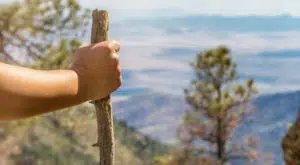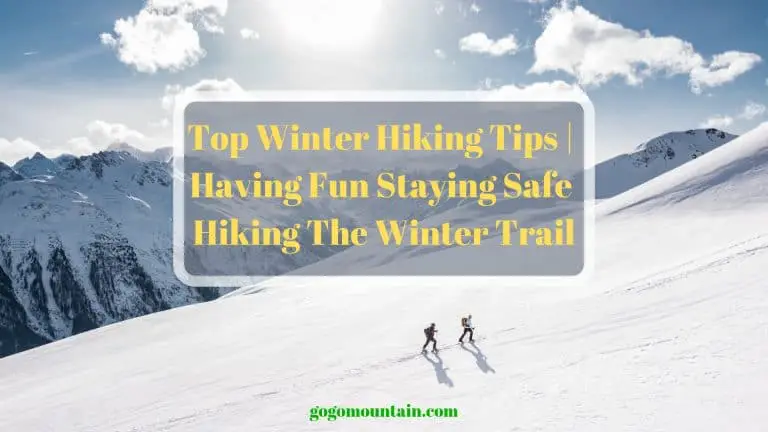How to Make a Walking Stick
Walking sticks are great for hiking, snowshoeing, or for any type of walk. Find out how to make a walking stick so that you can make them yourself.
If you can find a good solid stick that can withstand pressure, making a walking stick doesn’t require specific technical skills. For this project, you will need the following things, along with your stick material:
- Survival knife, cutter, or hack saw
- Glue
- A rubber cap
How to Make a Walking Stick – Step By Step Guide
When it comes to making your walking stick, you want to ensure you don’t rush through the steps. A good walking stick should last for at least a few years.

Consider the material
The material of a walking stick is the most important step to consider. You need to find a relatively straight stick.
The straighter the stick, the higher its durability. Bent sticks aren’t as supportive and they can even break under a bit of pressure.
A good straight stick that isn’t rotting or affected by insects is all you need. These can be found in the woods relatively easily. Make sure to inspect the stick first and even try it out for durability by leaning on it as you would when walking with a stick.
Find a good stick
A piece of wood or a branch can be great materials for walking sticks. You should refrain from cutting fresh branches out of trees as there are plenty of solid fallen branches to use instead.
Tree branches might look rough at first but after you polish them up they can look as good as many premium walking sticks of walking canes.
A walking stick’s diameter varies according to your needs. However, you should know a thin walking stick is lightweight. The thicker the stick is the harder you’ll have to work to get it off the ground with every step. If you plan on hiking or trekking, the best walking stick should have a diameter between 1 and 2 inches.
Cut it to size
Cutting the walking stick to the right size often creates confusion. Some people want these sticks to be rather short, similar to a walking cane so they can lean on them fully. Others want tall walking sticks that resemble those in skiing or hiking.
A tall walking stick is best for the ultimate versatility. While you might be able to move around with a short one, you will never feel out of place with a tall walking stick when venturing off the beaten path, through parks, trails, and even out trekking.
You can cut a stick to size using a good cutter, a survival knife, or a hack saw. A stick that is 1 inch in diameter can be cut with a cutter or a simple knife. Thicker sticks might need a saw. However, your stick is typically too thick if you can’t cut it with a utility knife out in nature. You want to avoid heavy sticks as you want to avoid heavy travel gear.
Clear the bark and branches
You can now prepare the stick visually. Removing the bark and all small branches attached to the stick is next. This can easily be done using a cutter. You can start from top to bottom slowly making your way down as you remove the bark.
At the end of this process, you should be left with a nearly perfect stick in smoothness. The wood underneath the bark is considerably smoother and nicer to hold.
You can also cut all branches as close to the stick as possible. This will save you from getting the stick stuck in your pants when walking.
Dry the stick
If you’re collecting the branch or piece of wood from nature you should let it dry at this point. It might take a few days out in the sun for the stick to dry completely, but this step cannot be skipped if you plan on walking with the stick for years.
Smooth out the stick
You will then need to smooth out the stick for rough edges. The easiest way to do it is with sandpaper. Power tools such as sanders aren’t needed here. A couple of course and fine sandpaper bits are sufficient to smooth out the surface of the stick.
You need to sand out the stick from top to bottom a couple of times with 50 sandpaper and move on to sanding it with 100 or 200 sandpaper. This will make it even smoother and it will keep your hand smooth no matter where you grip the stick.
Stain or paint the stick
If you want to protect the stick further you can stain it or paint it. The stick’s surface is prone to water damage and humidity damage. This can be avoided by staining the wood with a water repellent.
Painting the stick is just as efficient. Almost all wood paints are going to be great for this task.
Add a grip
A grip area of the stick needs to be pointed out further. You add a grip for a more comfortable hold of the stick. Grip materials can vary and you can use almost any materials you have on you or around the house. From old shoelaces wrapped around the stick to pieces of cloth you wrap a few times around the stick, you can use almost any type of fabric for a soft stick grip.
Add a rubber cap at the base
The base of the stick is prone to damage as it’s constantly in contact with the ground. Ideally, you’d add a rubber cap at the end of the stick to protect it from cracks and constant beating. However, other materials with a damping effect can work as well. Even a small water bottle plastic cap attached to the end of the stick is going to protect it.
Rubber remains the best material at the end of the stick for other reasons, however. The material has a great grip which means it will prevent the stick from sliding around and potentially keep you away from accidents.
If you’re already out in nature and you don’t have a piece of rubber to cut and adjust the stick, you can alternatively use a piece of cloth. Textiles were added to shoes by people living in remote areas for grip. This old-school technique can work well, at least for a few days before it rips.

Takeaway
Making a walking stick is a high satisfaction experience. You get to repurpose a piece of wood that sits out in nature and make it your own. While people are often spending a lot of money on walking sticks there are situations where simply making a simple one as a do-it-yourself project can be just as good.
However, you should remember to test out your walking stick once finished yet again. You want to ensure it can withstand the weight of your hand and that it can also take some of your weight. You can do this by leaning on the stick while walking. Cracking sounds are a clear indication your walking stick is not in good condition and you should look for another one.
If the walking stick is reliable, chances are you can use it for years. If you prefer to use it for a longer time you should always store it in a cool dry place to avoid humidity damaging the wood.







